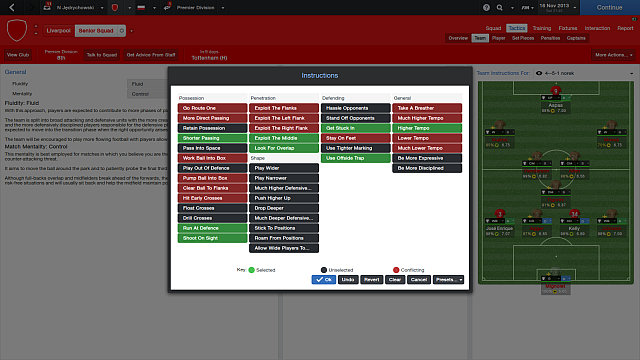Team instructions | Tactics
 Team - Team instructions - Tactics - Football Manager 2014 - Game Guide and Walkthrough">
Team - Team instructions - Tactics - Football Manager 2014 - Game Guide and Walkthrough">You can choose team instructions in Tactics->Team. They determine your team's general style of playing. You should spend some time to give the right instructions - without them, your players will never play at their best.
Detailed description below.
Style | You may choose from: Very rigid, Rigid, Balanced, Fluid, Very fluid. From left to right, the more rigid style, the less freedom the players have on the pitch. Defenders will only defend, attackers - attack. If you choose a more fluid style, the players will have more tactical freedom - attack will more often turn into defence and vice versa. |
Mentality | Contain - very defensive mentality, all players focused on keeping the ball and not letting the opponent score. Very useful at the end of the match, when you want to keep the score as it is. Defensive - also a defensive mentality, however the players will pass the ball to attackers for a counter attack. Counter - defensive playing on your side with looking for an opportunity to counter, defenders take part in the action. Standard - Balance between offence and defence. Control - mentality mainly for teams that keep the ball, setting the game's pace. It's an offensive mentality, effective against teams that prefer counters. Attack - more offensive mentality, recommended against weak opponents to push them into defence. Be careful not to get countered. Overload - mentality for the end of the match, when you tell all players to attack, hoping to score a goal. |
Instructions that you can give to the team concern several aspects like Possession or Defending. Remember that choosing some of them collides with other. For example, if you select Float crosses, it conflicts with Drill crosses, Get stuck in conflicts with Stay on feet etc.
Full list below.
Possession
Go route one | Immediate, fast getting the ball into the attacking third, may result in scoring an unexpected goal. |
More direct passing | Quicker transition from back to front with the ball covering longer distances. |
Retain possession | Instructs players to try to keep hold of the ball. |
Shorter passing | Shorter, more precise passing, retaining the ball for a longer time. |
Pass into space | Passing the ball into free spaces. |
Work ball into box | Tiki-taka, a lot of passes, retaining the ball until a breakthrough occurs. |
Play out of defence | Instructs defenders to pass their way out from the back without long passes. |
Pump ball into box | High, long passes into opposition's penalty area. |
Clear ball to flanks | Passing to attackers that wait on the sides of the pitch. |
Hit early crosses | Getting the ball into the penalty area as soon as possible. |
Float crosses | High, floating crosses with ball hanging in the air, gives your attackers time to position themselves. |
Drill crosses | Quick, powerful crosses, good for fast and strong attackers. |
Run at defence | Perfect for well-trained players, instructs them to run at the opposition more often than by default. |
Shoot on sight | More shooting from outside of the penalty area. |
Penetration
Exploit the flanks | Instructs to take advantage of wide play, useful if you have good side midfielders and defenders. |
Exploit the left flank | Wide play on the left side of the pitch, useful when you notice that one of opposition's defenders is weak. |
Exploit the right flank | Same as above, just on another side. |
Exploit the middle | The team will play in the middle, good when you have an experienced playmaker. |
Look for overlap | Players will keep hold of the ball until supporting player comes closer and run around the opposition. |
Defending
Hassle enemies | Instructs the players to give the opposition little time and space on the ball, attempting to force a mistake. |
Stand off opponents | Gives the opponents more time while your players retreat to defence. |
Get stuck in | Instructs the players to be aggressive and strong. It increases risk of fouls, so you should watch out for referees who give many cards. |
Stay on feet | Players will usually stay on their feet while making tackles instead of going to ground. |
Use tighter marking | The defenders will stay close to the opposition in defensive situations. |
Use offside trap | Makes your defenders use offside trap. With poor cooperation in your team you risk that you'll fail and the opposition will get to your goal easily. |
Shape
Play wider | Makes your players look to stretch the pitch and play wider. |
Play narrower | Your players will look to narrow the pitch, they will try to play in the middle. |
Much higher defensive line | Moves the defensive line towards the middle of the field, it will make intercepting opposition's long passes easier (as long as their attackers aren't faster than your defenders). |
Push higher up | Just like the instruction above, it moves the defenders towards the center. |
Drop deeper | Moves your players to your side. |
Much deeper defensive line | Moves your defensive line as close to your own goal as possible. |
Stick to positions | Makes the players stick to their set positions, limits their tactical freedom. |
Roam for positions | The players will look for positions, recommended for fluid playing style. |
Allow wide players to swap | It allows the players in wide attacking positions swap during the match and stay in their new positions for a while. |
General
Play wider | Makes your players look to stretch the pitch and play wider. |
Play narrower | Your players will look to narrow the pitch, they will try to play in the middle. |
Much higher defensive line | Moves the defensive line towards the middle of the field, it will make intercepting opposition's long passes easier (as long as their attackers aren't faster than your defenders). |
Push higher up | Just like the instruction above, it moves the defenders towards the center. |
Drop deeper | Moves your players to your side. |
Much deeper defensive line | Moves your defensive line as close to your own goal as possible. |
Stick to positions | Makes the players stick to their set positions, limits their tactical freedom. |
You are not permitted to copy any image, text or info from this page. This site is not associated with and/or endorsed by the SEGA or Sports Interactive. All logos and images are copyrighted by their respective owners.
Copyright © 2000 - 2025 Webedia Polska SA for gamepressure.com, unofficial game guides, walkthroughs, secrets, game tips, maps & strategies for top games.
